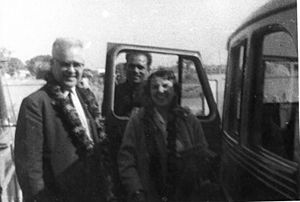Harry Huskey facts for kids
Quick facts for kids
Harry Huskey
|
|
|---|---|

Harry Huskey in 2011
|
|
| Born |
Harry Douglas Huskey
January 19, 1916 Whittier, North Carolina, U.S.
|
| Died | April 9, 2017 (aged 101) Santa Cruz, California, U.S.
|
| Citizenship | American |
| Alma mater | Ohio State University (Master & PhD) University of Idaho (Bachelor) |
| Spouse(s) | Velma Roeth (died 1991); Nancy Grindstaff (m. 1994, died 2015) |
| Awards | ACM Fellow (1994) Computer History Museum Fellow (2013) |
| Scientific career | |
| Fields | Mathematics |
| Institutions | University of California University of Pennsylvania |
| Thesis | Contributions to the Problem of Geocze (1943) |
| Doctoral students | Butler Lampson Niklaus Wirth |
Harry Douglas Huskey (born January 19, 1916 – died April 9, 2017) was an American pioneer in designing computers. He helped create some of the earliest electronic computers.
Contents
Harry Huskey's Early Life and Education
Harry Huskey was born in Whittier, North Carolina, in the beautiful Smoky Mountains. He grew up in Idaho. He was the first in his family to go to college.
He earned a bachelor's degree in math and physics from the University of Idaho. Later, he received his master's degree and then his PhD in 1943 from Ohio State University.
Working with Early Computers
In 1945, Huskey taught mathematics to U.S. Navy students at the University of Pennsylvania. During this time, he also worked part-time on the very first electronic computers, like the ENIAC and EDVAC. This was his first real experience with computers.
He spent a year in the United Kingdom at the National Physical Laboratory (NPL). There, he worked on the Pilot ACE computer with the famous computer scientist Alan Turing. He also helped with other early computer projects, including the EDVAC and SEAC computers.
Designing New Computers
Harry Huskey designed and managed the building of the Standards Western Automatic Computer (SWAC). This computer was built at the National Bureau of Standards in Los Angeles between 1949 and 1953.
He also designed the G-15 computer for a company called Bendix Aviation Corporation. This machine weighed about 950 pounds (430 kg) and could be operated by just one person. Harry Huskey even had one of these computers at his home! Today, that computer is kept at the Smithsonian Institution in Washington, D.C..
Teaching and Later Career
After working at the National Bureau of Standards for five years, Huskey became a professor. He joined the University of California, Berkeley in 1954. Later, in 1966, he moved to the University of California, Santa Cruz.
In 1967, he helped start the computer and information science program at UC Santa Cruz. He also became the director of its computer center. In 1986, UC Santa Cruz named him a professor emeritus, which means he was a retired professor who kept his title.
While at Berkeley, he guided the research of Niklaus Wirth, who later became a famous designer of programming languages.
Harry Huskey retired at age 70 in 1986. In 1994, he was recognized as a Fellow of the Association for Computing Machinery. A curator at the Computer History Museum once said that Dr. Huskey was "present at some of computing's greatest moments."
Harry Huskey's Personal Life
Harry Huskey married Velma Roeth in 1939, and they had four children. Velma passed away in 1991. In 1994, he married Nancy Grindstaff, who passed away in 2016. He lived in Santa Cruz, California.
In 1950, Harry Huskey appeared on a radio show called You Bet Your Life, hosted by Groucho Marx. He was introduced as the designer of an "electronic brain."
Selected Works
- Huskey, H. D. Harry D. Huskey: His Story. BookSurge Publishing, 2004. ISBN: 1-59457-680-7.
- Huskey, H. D. The ACE Test Assembly, the Pilot ACE, the Big ACE, and the Bendix G15. In Copeland, B. J., Alan Turing's Automatic Computing Engine, chapter 13, pages 281–295. Oxford University Press, 2005. ISBN: 0-19-856593-3.
- (with Huskey, Velma R). Lady Lovelace and Charles Babbage. 1980 Annals of the History of Computing (Volume: 2, Issue: 4 )
Awards and Recognition
In 2013, the Computer History Museum honored Harry Huskey by naming him a Museum Fellow. This award recognized his important work on early computer systems and his many years of teaching about computers.


